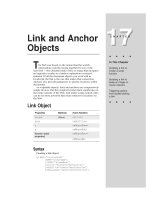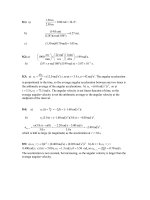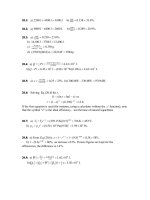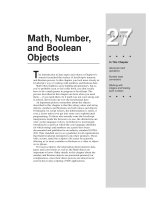Tài liệu Javascript bible_ Chapter 31 pptx
Bạn đang xem bản rút gọn của tài liệu. Xem và tải ngay bản đầy đủ của tài liệu tại đây (107.91 KB, 20 trang )
Control
Structures
Y
ou get up in the morning, go about your day’s business,
and then turn out the lights at night. That’s not much
different from what a program does from the time it starts to
the time it ends. But along the way, both you and a program
take lots of tiny steps, not all of which advance the
“processing” in a straight line. At times, you have to control
what’s going on by making a decision or repeating tasks until
the whole job is finished. Control structures are the facilities
that make these tasks possible in JavaScript.
JavaScript control structures follow along the same lines of
many programming languages, particularly with additions
made in Navigator 4 and Internet Explorer 4 (for JavaScript
1.2). Basic decision-making and looping constructions satisfy
the needs of just about all programming tasks.
If and If. . .Else Decisions
Nav2 Nav3 Nav4 IE3/J1 IE3/J2 IE4/J3
Compatibility
✔✔✔✔ ✔ ✔
JavaScript programs frequently have to make decisions
based on the current values of variables or object properties.
Such decisions can have only two possible outcomes at a
time. The factor that determines the path the program takes
at these decision points is the truth of some statement. For
example, when you enter a room of your home at night, the
statement under test is something like “It is too dark to see
without a light.” If that statement is true, you switch on the
light; if that statement is false, you carry on with your
primary task.
Simple decisions
JavaScript syntax for this kind of simple decision always
begins with the keyword
if
, followed by the condition to test,
and then the statements that execute if the condition yields a
31
31
CHAPTER
✦ ✦ ✦ ✦
In This Chapter
How to branch script
execution down
multiple paths
Looping through
ordered collections
of data
How to use
labels to assist in
script navigation
✦ ✦ ✦ ✦
646
Part III ✦ JavaScript Object and Language Reference
true result. JavaScript uses no “then” keyword (as some other languages do); the
keyword is implied by the way the various components of this construction are
surrounded by parentheses and braces. The formal syntax is
if (condition) {
statementsIfTrue
}
This means that if the condition is true, program execution takes a detour to
execute statements inside the braces. No matter what happens, the program
continues executing statements beyond the closing brace (
}
). If household
navigation was part of the scripting language, the code would look something like
this:
if (tooDark == true) {
feel for light switch
turn on light switch
}
If you’re not used to C/C++, the double equals sign may have caught your eye.
You learn more about this type of operator in the next chapter, but for now, know
that this operator compares the equality of items on either side of it. In other
words, the
condition
statement of an
if
construction must always yield a
Boolean (true or false) value. Some object properties, you may recall, are
Booleans, so you can stick a reference to that property into the
condition
statement by itself. Otherwise, the
condition
statement consists of two values
separated by a comparison operator, such as
==
(equals) or
!=
(does not equal).
Let’s look at some real JavaScript. The following function receives a form object
containing a text object called
entry
:
function notTooHigh(form) {
if (parseInt(form.entry.value) > 100) {
alert(“Sorry, the value you entered is too high. Try
again.”)
return false
}
return true
}
The
condition
(in parentheses) tests the contents of the field against a hard-
wired value of 100. If the entered value is larger than that, the function alerts you
and returns a false value to the calling statement elsewhere in the script. But if the
value is less than 100, all intervening code is skipped and the function returns true.
About (condition) expressions
A lot of condition testing for control structures compares a value against some
very specific condition, such as a string being empty or a value being null. You can
use a couple of shortcuts to take care of many circumstances. Table 31-1 details
the values that evaluate to a true or false (or equivalent) to satisfy a control
structure’s
condition expression.
647
Chapter 31 ✦ Control Structures
Table 31-1
Condition value equivalents
True False
Nonempty string Empty string
Nonzero number 0
Nonnull value Null
Object exists Object doesn’t exist
Property is defined Undefined property
Instead of having to spell out an equivalency expression for a condition
involving these kinds of values, you can simply supply the value to be tested. For
example, if a variable named
myVal
might reach an
if
construction as null, an
empty string, or a string value for further processing, you can use the following
shortcut:
if (myVal) {
do processing on myVal
}
All null or empty string conditions evaluate to false, so only the cases of
myVal
being a processable value get inside the
if
construction.
Complex decisions
The simple type of
if
construction described earlier is fine when the decision is
to take a small detour before returning to the main path. But not all decisions— in
programming or in life— are like that. To present two alternate paths in a
JavaScript decision, you can add a component to the construction. The syntax is
if (condition) {
statementsIfTrue
} else {
statementsIfFalse
}
By appending the
else
keyword, you give the
if
construction a path to follow
in case the
condition
evaluates to false. The statementsIfTrue and
statementsIfFalse do not have to be balanced in any way: One statement could be
one line of code, the other one hundred lines. But when either one of those
branches completes, execution continues after the last closing brace. To
demonstrate how this construction can come in handy, the following example is a
script fragment that assigns the number of days in February based on whether the
year is a leap year (using modulo arithmetic, explained in the next chapter, to
determine if the year is evenly divisible by four):
var howMany = 0
648
Part III ✦ JavaScript Object and Language Reference
var theYear = 1993
if (theYear % 4 == 0) {
howMany = 29
} else {
howMany = 28
}
Here is a case where execution has to follow only one of two possible paths to
assign the number of days to the
howMany
variable. Had I not used the
else
portion, as in
var howMany = 0
var theYear = 1993
if (theYear % 4 == 0) {
howMany = 29
}
howMany = 28
then the variable would always be set to 28, occasionally after momentarily
being set to 29. The
else
construction is essential in this case.
Nesting if. . .else statements
Designing a complex decision process requires painstaking attention to the logic
of the decisions your script must process and the statements that must execute for
any given set of conditions. The need for many complex constructions disappears
with the advent of Navigator 4’s
switch
construction (described later in this
chapter), but there may still be times when you must fashion complex decision
behavior out of a series of nested
if...else
constructions. Without a JavaScript-
aware text editor to help keep everything properly indented and properly
terminated (with closing braces), you have to monitor the authoring process very
carefully. Moreover, the error messages that JavaScript provides when a mistake
occurs (see Chapter 45) may not point directly to the problem line, but only to the
region of difficulty.
Another important point to remember about nesting
if...else
statements in
JavaScript before Version 1.2 is that the language does not provide a mechanism to
break out of a nested part of the construction. For that reason, you have to
construct complex assemblies with extreme care to make sure only the desired
statement executes for each set of conditions. Extensive testing, of course, is also
required (see Chapter 45).
To demonstrate a deeply nested set of
if...else
constructions, Listing 31-1
presents a simple user interface to a complex problem. A single text object asks
the user to enter one of three letters, A, B, or C. The script behind that field
processes a different message for each of the following conditions:
✦ The user enters no value.
✦ The user enters A.
✦ The user enters B.
✦ The user enters C.
✦ The user enters something entirely different.
Note
649
Chapter 31 ✦ Control Structures
What’s with the formatting?
Indentation of the if construction and the further indentation of the statements executed
on a true condition are not required by JavaScript. What you see here, however, is a con-
vention that most JavaScript scripters follow. As you write the code in your text editor, you
can use the Tab key to make each indentation level. The browser ignores these tab char-
acters when loading the HTML documents containing your scripts. Until HTML editors are
available that automatically format JavaScript listings for you, you have to manually make
the listings readable and pretty.
Listing 31-1: Deeply Nested if...else Constructions
<HTML>
<HEAD>
<SCRIPT LANGUAGE="JavaScript">
function testLetter(form){
inpVal = form.entry.value // assign to shorter variable name
if (inpVal != "") { // if entry is not empty then dive in...
if (inpVal == "A") { // Is it an "A"?
alert("Thanks for the A.")
} else if (inpVal == "B") { // No. Is it a "B"?
alert("Thanks for the B.")
} else if (inpVal == "C") { // No. Is it a "C"?
alert("Thanks for the C.")
} else { // Nope. None of the above
alert("Sorry, wrong letter or case.")
}
} else { // value was empty, so skipped all other stuff
above
alert("You did not enter anything.")
}
}
</SCRIPT>
</HEAD>
<BODY>
<FORM>
Please enter A, B, or C:
<INPUT TYPE="text" NAME="entry" onChange="testLetter(this.form)">
</FORM>
</BODY>
</HTML>
Each condition executes only the statements that apply to that particular
condition, even if it takes several queries to find out what the entry is. You do not
650
Part III ✦ JavaScript Object and Language Reference
need to break out of the nested construction because when a true response is
found, the relevant statement executes, and no other statements occur in the
execution path to run.
Even if you understand how to construct a hair-raising nested construction such
as the one in Listing 31-1, the trickiest part is making sure that each left brace has
a corresponding right brace. My technique for ensuring this pairing is to enter the
right brace immediately after I type the left brace. I typically type the left brace,
press Enter twice (once to open a free line for the next statement, once for the line
that is to receive the right brace), tab, if necessary, to the same indentation as the
line containing the left brace, and then type the right brace. Later, if I have to
insert something indented, I just push down the right braces that I entered earlier.
If I keep up this methodology throughout the process, the right braces appear at
the desired indentation when I’m finished, even if they end up being dozens of
lines below their original spot.
Conditional Expressions
Nav2 Nav3 Nav4 IE3/J1 IE3/J2 IE4/J3
Compatibility
✔ ✔ ✔ ✔ ✔ ✔
While I’m showing you decision-making constructions in JavaScript, now is a good
time to introduce a special type of expression that you can use in place of an
if. . .
else
control structure for a common type of decision — the instance where you
want to assign one of two values to a variable, depending on the outcome of some
condition. The formal definition for the conditional expression is as follows:
variable = (condition) ? val1 : val2
This means that if the Boolean result of the
condition
statement is true,
JavaScript assigns val1 to the variable; otherwise, it assigns val2 to the variable.
Like other instances of
condition
expressions, this one must also be written
inside parentheses. The question mark is key here, as is the colon separating the
two possible values.
A conditional expression, though not particularly intuitive or easy to read inside
code, is very compact. Compare an
if. . .else
version of an assignment
decision that follows
var collectorStatus
if (CDCount > 500) {
collectorStatus = “fanatic”
} else {
collectorStatus = “normal”
}
with the conditional expression version:
var collectorStatus = (CDCount > 500) ? “fanatic” : “normal”
651
Chapter 31 ✦ Control Structures
The latter saves a lot of code lines (although the internal processing is the same
as an
if...else
construction). Of course, if your decision path contains more
statements than just one setting the value of a variable, the
if...else
or
switch
construction is preferable. This shortcut, however, is a handy one to remember
when you need to perform very binary actions, such as setting a true-or-false flag
in a script.
Repeat (for) Loops
Nav2 Nav3 Nav4 IE3/J1 IE3/J2 IE4/J3
Compatibility
✔ ✔ ✔ ✔ ✔ ✔
As you have seen in numerous examples throughout previous chapters, the
capability to cycle through every entry in an array or through every item of a form
element is vital to many JavaScript scripts. Perhaps the most typical operation is
inspecting a property of many similar items in search of a specific value, such as to
determine which radio button in a group is selected. One JavaScript structure that
allows for these repetitious excursions is the
for
loop, so named after the keyword
that begins the structure. Two other structures, called the
while
loop and
do-
while
loop, are covered in following sections.
The JavaScript
for
loop lets a script repeat a series of statements any number
of times and includes an optional loop counter that can be used in the execution of
the statements. The following is the formal syntax definition:
for ( [initial expression]; [condition]; [update expression]) {
statements
}
The three statements inside the parentheses ( parameters to the
for
statement)
play a key role in the way a
for
loop executes.
An initial expression in a
for
loop is executed one time, the first time the
for
loop begins to run. The most common application of the initial expression is to
assign a name and starting value to a loop counter variable. Thus, it’s not
uncommon to see a
var
statement that both declares a variable name and assigns
an initial value (generally 0 or 1) to it. An example is
var i = 0
You can use any variable name, but conventional usage calls for the letter
i
,
which is short for index. If you prefer the word
counter
or something else that
reminds you of what the variable represents, that’s fine, too. In any case, the
important point to remember about this statement is that it executes once at the
outset of the
for
loop.
The second statement is a condition, precisely like the
condition
statement
you saw in
if
constructions earlier in this chapter. When a loop-counting variable
is established in the initial expression, the condition statement usually defines how
652
Part III ✦ JavaScript Object and Language Reference
high the loop counter should go before the looping stops. Therefore, the most
common statement here is one that compares the loop counter variable against
some fixed value — is the loop counter less than the maximum allowed value? If
the condition is false at the start, the body of the loop is not executed. But if the
loop does execute, then every time execution comes back around to the top of the
loop, JavaScript reevaluates the condition to determine the current result of the
expression. If the loop counter increases with each loop, eventually the counter
value goes beyond the value in the condition statement, causing the condition
statement to yield a Boolean value of false. The instant that happens, execution
drops out of the
for
loop entirely.
The final statement, the update expression, is executed at the end of each loop
execution — after all statements nested inside the
for
construction have run.
Again, the loop counter variable can be a factor here. If you want the counter value
to increase by one the next time through the loop (called incrementing the value),
you can use the JavaScript operator that makes that happen: the
++
operator
appended to the variable name. That task is the reason for the appearance of all
those
i++
symbols in the
for
loops you’ve seen already in this book. You’re not
limited to incrementing by one. You can increment by any multiplier you want or
even drive a loop counter backwards by decrementing the value (
i--
).
Now let’s take this knowledge and beef up the formal syntax definition with one
that takes into account a typical loop-counting variable,
i
, and the common ways
to use it:
//incrementing loop counter
for (var i = minValue; i <= maxValue; i++) {
statements
}
//decrementing loop counter
for (var i = maxValue; i >= minValue; i--) {
statements
}
In the top format, the variable,
i
, is initialized at the outset to a value equal to
that of minValue. Variable
i
is immediately compared against maxValue. If
i
is less
than or equal to maxValue, processing continues into the body of the loop. At the
end of the loop, the update expression executes. In the top example, the value of
i
is incremented by 1. Therefore, if
i
is initialized as 0, then the first time through
the loop, the
i
variable maintains that 0 value during the first execution of
statements in the loop. The next time around, the variable has the value of 1.
As you may have noticed in the formal syntax definition, each of the parameters
to the
for
statement is optional. For example, the statements that execute inside
the loop may control the value of the loop counter based on data that gets
manipulated in the process. Therefore, the update statement would probably
interfere with the intended running of the loop. But I suggest that you use all three
parameters until such time as you feel absolutely comfortable with their roles in
the
for
loop. If you omit the condition statement, for instance, and you don’t









